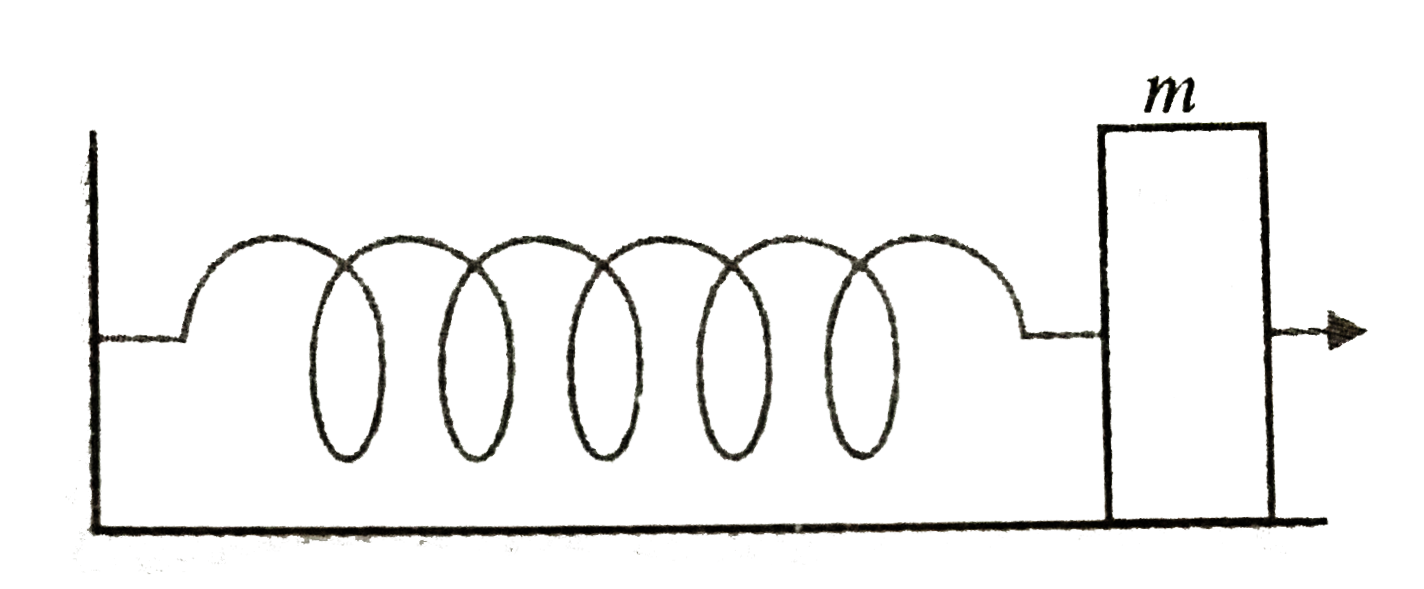A mass of 0.1 kg hangs at the end of a spring. When a mass of 0.01 kg more is added at the end of the spring, it stretches by 5 cm more. When the extra 0.01 kg mass is removed, determine the time period of vibration of the system.
To solve the problem step by step, we will first determine the spring constant k using the information provided and then calculate the time period of the oscillation.
Step 1: Understand the problem
We have a mass of 0.1kg hanging from a spring. When an additional mass of 0.01kg is added, the spring stretches by 5cm (which is 0.05m). We need to find the time period of the mass when the additional mass is removed.
Step 2: Establish the equilibrium conditions
1. When the mass 0.1kg is hanging, the force due to gravity is:
F1=m1g=0.1×g
where g is the acceleration due to gravity (approximately 10m/s2).
The spring force at this point is:
Fspring=kx0
where x0 is the initial extension of the spring due to the 0.1kg mass.
From equilibrium:
kx0=0.1g(1)
2. When the additional mass 0.01kg is added, the total mass becomes 0.11kg. The total force due to gravity is:
F2=(0.1+0.01)g=0.11g
The spring force now is:
Fspring=k(x0+0.05)
From equilibrium:
k(x0+0.05)=0.11g(2)
Step 3: Solve for k and x0
From equation (1):
x0=0.1gk
Substituting x0 into equation (2):
k(0.1gk+0.05)=0.11g
This simplifies to:
0.1g+0.05k=0.11g
Rearranging gives:
0.05k=0.11g−0.1g=0.01g
Thus,
k=0.01g0.05=0.01×100.05=2N/m
Step 4: Calculate the time period T
The time period T of a mass-spring system is given by:
T=2π√mk
Substituting m=0.1kg and k=2N/m:
T=2π√0.12=2π√0.05
Calculating √0.05:
√0.05≈0.2236
Thus,
T≈2π×0.2236≈1.4s
Final Answer
The time period of vibration of the system is approximately 1.4s.
We have a mass of 0.1kg hanging from a spring. When an additional mass of 0.01kg is added, the spring stretches by 5cm (which is 0.05m). We need to find the time period of the mass when the additional mass is removed.
1. When the mass 0.1kg is hanging, the force due to gravity is:
F1=m1g=0.1×g
where g is the acceleration due to gravity (approximately 10m/s2).
The spring force at this point is:
Fspring=kx0
where x0 is the initial extension of the spring due to the 0.1kg mass.
kx0=0.1g(1)
F2=(0.1+0.01)g=0.11g
The spring force now is:
Fspring=k(x0+0.05)
k(x0+0.05)=0.11g(2)
From equation (1):
x0=0.1gk
k(0.1gk+0.05)=0.11g
This simplifies to:
0.1g+0.05k=0.11g
Rearranging gives:
0.05k=0.11g−0.1g=0.01g
Thus,
k=0.01g0.05=0.01×100.05=2N/m
The time period T of a mass-spring system is given by:
T=2π√mk
Substituting m=0.1kg and k=2N/m:
T=2π√0.12=2π√0.05
Calculating √0.05:
√0.05≈0.2236
Thus,
T≈2π×0.2236≈1.4s
The time period of vibration of the system is approximately 1.4s.
Topper's Solved these Questions
- OSCILLATIONS BOOK - MODERN PUBLICATIONCHAPTER - OSCILLATIONS EXERCISE - PRACTICE PROBLEMS
15 Videos
- OSCILLATIONS BOOK - MODERN PUBLICATIONCHAPTER - OSCILLATIONS EXERCISE - PRACTICE PROBLEMS 2
20 Videos
- MOTION IN A STRAIGHT LINE BOOK - MODERN PUBLICATIONCHAPTER - MOTION IN A STRAIGHT LINE EXERCISE - CHAPTER PRACTICE TEST
16 Videos
- PHYSICAL WORLD BOOK - MODERN PUBLICATIONCHAPTER - PHYSICAL WORLD EXERCISE - Revision exercises (Long answer questions)
6 Videos
Similar Questions
A 0.2kg of mass hangs at the end of a spring. When 0.002kg more mass is added to the end of the spring, it stretches 7 cm more. If the 0.02 kg mass is removed what will be the period of vibration of the system?
View SolutionA 50g mass hangs at the end of a massless spring. When 20g more are added to the end of the spring, it stretches 7.0cm more. (a) Find the spring constant. (b) If the 20g are now removed, what will be the period of the motion ?
View Solution
Knowledge Check
When a mass m is hung on a spring, the spring stretched by 6 cm. If the loaded spring is pulled downward a little and released, then the period of vibration of the system will be
A0.27 sB0.35 sC0.49 sD0.64 sA mass of 1 kg is hanged through a spring. The spring is stretched through 1cm. What is the energy stared in spring?
A0.449JB0.049JC4.9JD49JThree mass 0.1 kg ,0.3 kg and 0.4 kg are suspended at end of a spring. When is 0.4 kg mass is removed , the system oscillates with a period 2 s . When the 0.3 kg mass is also removed , the system will oscillates with a period
A1 sB2 sC3 sD4 s
A spring of force constant 1200Nm−1 is mounted on a horizontal table as shown in figure. A mass of 3.0kg is attached to the free end of the spring, pulled side ways to a distance of 2.0cm and released. Determing.
(a) the frequency of oscillation of the mass.
(b) the maximum acceleration of the mass.
(c) the maximum speed of the mass.

View SolutionA mass of 1kg is hanged through a spring. The spring is stretched through 1cm. What is the energy stared in spring?
View SolutionA mass suspended on a vertical spring oscillates with a period of 0.5s. When the mass is allowed to hang at rest, the spring is stretched by
View SolutionA weightless spring of length 60 cm and force constant 100Nm−1 is kept straight and unstretched on a smooth horizontal table and its ends are rigidly fixed. A mass of 0.25 kg is attached at the middle of the spring and is slightly displaced along the length. The time period of the oscillation of the mass is
View SolutionWhen a force of 0.1 N is applied, the spring is stretched by 1.5 cm. The spring is cut into three parts and one part is stretched by 3 cm. Find the force required for doing so.
View Solution
